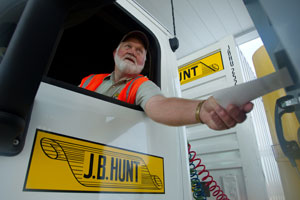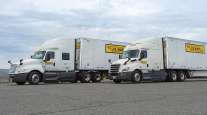Higher Rates Trigger 11% Profit Jump at J.B. Hunt

The Lowell, Arkansas-based company that is No. 3 on the Transport Topics Top 100 list of the largest U.S. and Canadian for-hire carriers reported revenue of $1.54 billion, down less than 1%. Fuel surcharge revenue fell by $100 million compared with last year’s quarter. Earnings in the 2014 second quarter were $93.4 million, or 79 cents.
Profit before interest and taxes rose to $174 million from $159 million despite $14.1 million in one-time technology-related costs.
“The increase in operating income was primarily due from customer rate increases, less reliance on outsourced intermodal drayage and dedicated capacity coverage, load growth, freight mix changes and improved equipment fuel economy,” the company statement said.
At the Intermodal unit that generated about two-thirds of profit, revenue fell 3% to $905 million and loads rose 2%. Its operating income was $118.6 million, a 5% improvement.
“The lingering effects of disruptive shipping patterns due to West Coast port issues, slow rail-service recovery and a softer consumer-driven freight demand all contributed to slower load volume growth,” the company report said.
Revenue at the Dedicated unit rose 5% to $367 million, and operating income was 34% higher. The business added 413 trucks, a 6% capacity increase, primarily to serve customers who converted from private fleet operations.
The brokerage unit’s revenue rose less than 1% to $174 million, but operating income dropped 21%. The profit margin per load rose 2.5 percentage points to 15.2%. Earnings were hurt by technology costs and personnel-related expense as five more offices were opened.
In the Truck unit, operating income was $9.7 million, up 3%, and revenue was $98 million, down 3.5%. Higher rates, the addition of 213 trucks and lower costs for maintenance as well as fuel aided the results. Profit in that business was reduced by increased driver hiring expense and reduced gains from equipment sales.




